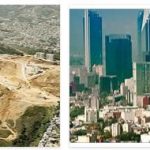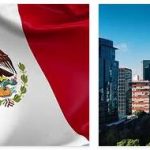Cancun is one of the most famous resorts on the Gulf Coast, located on the Yucatan Peninsula. It is built on a long and narrow 25-kilometer sand spit, which faces the Caribbean Sea on one side and the lagoon that has formed between the spit and the shore on the other. The resort is famous for its endless beaches with white sand, crystal clear sea water and proximity to the architectural monuments of the Maya civilization.
This is the most visited and popular resort in Mexico. In 2012, a monument was unveiled at the resort to the outstanding Russian scientist Yuri Knorozov, who made a significant contribution to deciphering the Mayan script. The predominant nationality of tourists at the resort are Americans.
The coastline of the Cancun resort from a bird’s eye view resembles the number “7”, dividing the resort into two parts: “short” and “long”. The short part is characterized by a calm sea, since the island of Isla Mujeres closes it from the ocean. But it has its drawbacks – the presence of algae in the water, which clog the beach and make the sea not so transparent. In addition, there is a port in this part of the beach area, which is also bad for the purity of the water. The advantages of staying in hotels in this part of the resort is the proximity to entertainment venues and the city center. To the city from here 10 minutes by bus (runs with a very short break).
The main feature of the “long part” is constant waves, since they do not encounter any obstacles on their way from the open ocean. But at the same time, you can not only splash in the sea, but also feel the healing power of water massage – no worse than in a jacuzzi. The water in this part of the resort is crystal clear, and since there are no algae, the beach is in perfect condition. The seabed is sandy, but the sand does not rise when entering the water. Minus the “long part” – this beach is further from the city, 15-20 minutes by bus.
A large number of hotels of various levels, modern shopping and entertainment areas, sports complexes, fitness centers, dozens of discos and youth clubs have been built for vacationers in Cancun.
Cancun has a very mild maritime climate, slightly dependent on the time of year.
Excursions from Cancun:
Chichen Itza – the main historical zone of the area – the sacred Mayan city (205 km from Cancun). This is the most famous and best restored city, where there are such delightful Mayan buildings as the pyramid of Kukulkan consisting of nine platforms with a temple on top, the largest and oldest building in the city – the Palace of the Nuns, the astronomical observatory El Caracol (“snail”), square Temple of the Eagles and Tigers, Pyramid of Osario and the sacred “cenote” (well) where sacrifices were made to the gods, Temple of the Warriors with its famous figure of the god Chaak, a ball game with the Temple of the Jaguar and the “northern temple” which may have been used for sacrifices, and many other monuments of the ancient Indian civilization.
Xcaret Ecopark is located 72 km from Cancun on the bay. This is a well-equipped recreation center with an abundance of tropical fauna, well-equipped beaches, a zoo, water attractions, underground rivers, an aquarium, caves, bars and restaurants, a small museum and much more. One of the main highlights of Shkaret is one of the best butterfly pavilions in the world.
Shel-Ha (122 km from Cancun) is a national park, which is a natural aquarium that arose naturally in a mountain cave, fed partly by sea, partly by fresh water from underground rivers. Surprisingly clean and transparent water allows you to see exotic fish of unusual colors, and lush vegetation amazes with a range of shades.
Koba – archaeological zone 167 km. from Cancun, in the heart of the jungle, with many ancient structures and numerous caves, most of which have not yet been fully explored.
Just an hour away is Tulum, the former main Mayan port and one of the most famous archaeological sites on the coast. The city is surrounded on three sides by stone walls, and from the sea – by hard-to-reach cliffs fifteen meters high, and is the only fortification of the Mayan empire on the coast, as well as the last stronghold of the Indians, which existed until 1554, and repeatedly served as a refuge for the rebellious Indians. The Temple of Frescoes (De los Frescos), the Temple of the Descending God, the Temple of the God of the Wind, the Temple of the Sea, as well as an almost 400-meter ceremonial center have survived to this day.





